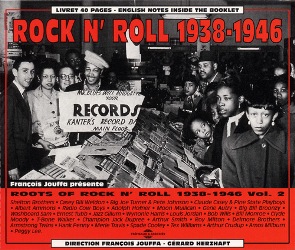Roots of Rock N' Roll Vol.2 (1938 – 1946) (1997)
Roots of Rock N' Roll Vol.2 (1938 – 1946) (1997)

CD1 01 - Shelton Brothers - Aura Lee (Love Me Tender) (2:42) 02 - Casey Bill Weldon - You Gotta Do Your Duty (2:46) 03 - Big Joe Turner & Pete Johnson - Roll 'em Pete (2:50) 04 - Claude Casey & Pine State Playboys - Pine State Honky Tonk (2:24) 05 - Albert Ammons - Shot For Joy (2:24) play 06 - Shelton Brothers - On The Owl Hoot Trail (2:58) 07 - Big Joe Turner & Pete Johnson - Baby Look At You (3:02) 08 - Radio Cow Boys - Mississippi Muddle (2:27) 09 - Adolph Hofner - Joe Turner Blues (2:45) 10 - Moon Mullican - Pipeliner's Blues (2:54) 11 - Gene Autry - Blueberry Hill (2:39) 12 - Big Bill Bronzy - Rocking Chair Blues (2:50) 13 - Washboard Sam - Come On Back (2:41) 14 - Ernest Tubb - You Nearly Lose Your Mind (2:48) 15 - Jazz Gillum - Tell Me Mama (3:11) 16 - Wynonie Harris - Who Threw The Whiskey In The Well (3:01) 17 - Louis Jordan - Cal'donia Boogie (2:42) play 18 - Bob Wills - Roly Poly (2:37) CD2 01 - Bill Monroe - Rocky Road Blues (2:36) 02 - Clyde Moody - Two Timin' Blues (2:48) 03 - T-Bone Walker - T-Bone Boogie (3:05) 04 - Champion Jack Dupree - Let's Have A Ball (2:25) play 05 - Arthur Smith - Guitar Boogie (3:22) 06 - Roy Milton - Milton's Boogie (2:50) 07 - Delmore Brothers - Hilbilly Boogie (2:45) 08 - Amstrong Twins - Mandolin Boogie (3:00) 09 - Hank Penny - Steel Guitar Stomp (2:51) 10 - Louis Jordan - Choo Choo Ch'boogie (2:45) 11 - Delmore Brothers - Boogie Woogie Baby (2:47) 12 - Merle Travis - Cincinnatti Lou (2:37) 13 - Spade Cooley - Oklahoma Stomp (2:52) 14 - Tex Williams - I Got Texas In My Soul (2:58) 15 - Spade Cooley - Three Way Boogie (2:41) play 16 - Arthur Crudup - That's All Right (2:54) 17 - Amos Milburn - Down The Road Apiece (3:00) 18 - Peggy Lee - Everything's Moving Too Fast (2:59)
The origins of rock and roll have been fiercely debated by commentators and historians of music. There is general agreement that it arose in the Southern United States - a region which would produce most of the major early rock and roll acts - through the meeting of various influences that embodied a merging of the African musical tradition with European instrumentation. The migration of many freed slaves and their descendants to major urban centers like Memphis and north to New York City, Detroit, Chicago, Cleveland and Buffalo meant that black and white residents were living in close proximity in larger numbers than ever before, and as a result heard each other's music and even began to emulate each other's fashions. Radio stations that made white and black forms of music available to both groups, the development and spread of the gramophone record, and African American musical styles such as jazz and swing which were taken up by white musicians, aided this process of "cultural collision."
The immediate roots of rock and roll lay in the rhythm and blues, then called "race music", and country music of the 1940s and 1950s. Particularly significant influences were jazz, blues, gospel, country, and folk. Commentators differ in their views of which of these forms were most important and the degree to which the new music was a re-branding of African American rhythm and blues for a white market, or a new hybrid of black and white forms.
In the 1930s jazz, and particularly swing, both in urban based dance bands and blues-influenced country swing, was among the first music to present African American sounds for a predominately white audience. The 1940s saw the increased use of blaring horns (including saxophones), shouted lyrics and boogie woogie beats in jazz based music. During and immediately after World War II, with shortages of fuel and limitations on audiences and available personnel, large jazz bands were less economical and tended to be replaced by smaller combos, using guitars, bass and drums. In the same period, particularly on the West Coast and in the Midwest, the development of jump blues, with its guitar riffs, prominent beats and shouted lyrics, prefigured many later developments. In the documentary film Hail! Hail! Rock 'n' Roll, Bruce Springsteen demonstrates a compelling explanation of how Chuck Berry developed his brand of rock and roll, by transposing the familiar two-note lead line of jump blues piano directly to the electric guitar, creating what is instantly recognizable as rock guitar. Similarly, country boogie and Chicago electric blues supplied many of the elements that would be seen as characteristic of rock and roll.
download (mp3 @320 kbs):
Last Updated (Monday, 31 December 2018 23:58)








